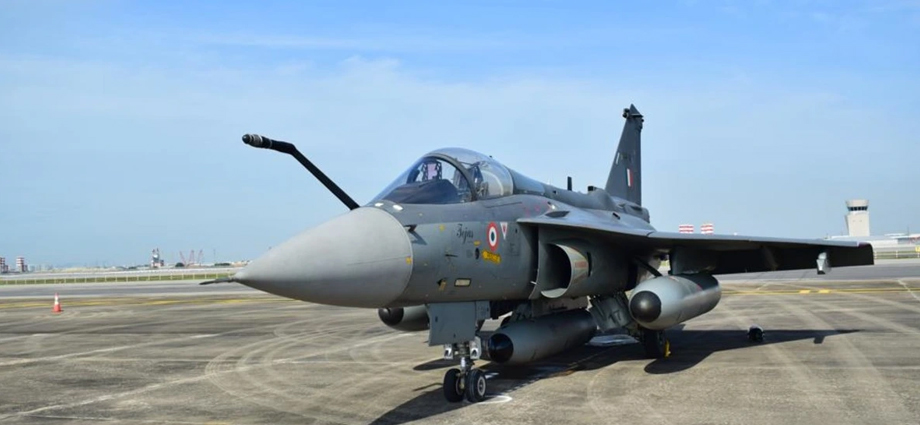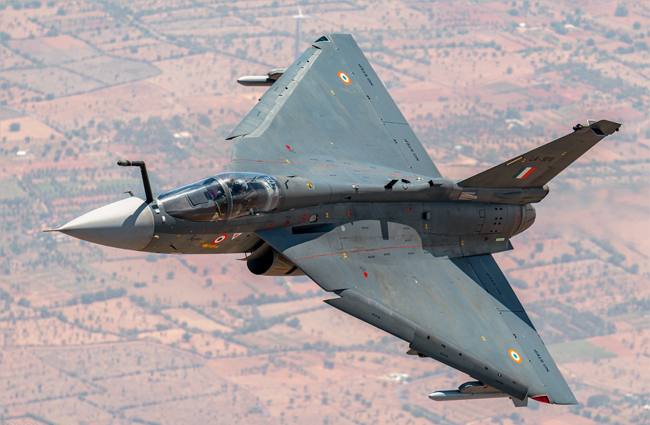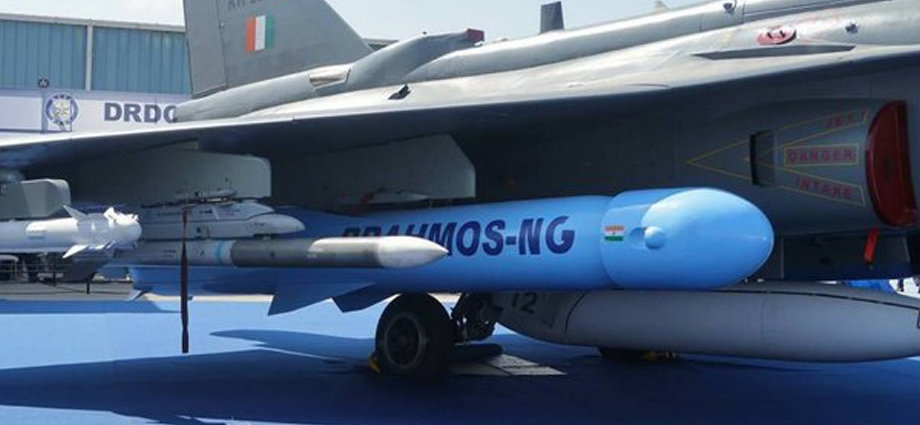
HAL Tejas is an indigenous light-weight, single-engine, multi-role fighter jet designed and developed by the Aeronautical Development Agency (ADA) in collaboration with Hindustan Aeronautics Limited (HAL) in India. The development of the Tejas began in the 1980s, and the first prototype was flown in 2001.
The Tejas is a fourth-generation fighter jet that features state-of-the-art avionics, fly-by-wire flight control system, digital flight control computer, and an advanced cockpit with multi-functional displays. The aircraft is designed to be highly maneuverable and can carry a variety of weapons, including air-to-air missiles, air-to-surface missiles, and precision-guided munitions.
The Tejas has a length of 13.2 meters, a wingspan of 8.2 meters, and a maximum takeoff weight of 13,500 kg. It is powered by a single General Electric F404-GE-IN20 turbofan engine, which provides a maximum speed of Mach 1.8 and a maximum range of 3,000 km.
The Tejas has been inducted into the Indian Air Force (IAF) and has already been used in various combat and training missions. The aircraft has undergone several upgrades, including the addition of new weapons, avionics, and electronic warfare systems. The latest version of the Tejas, the Tejas Mk-1A, features several upgrades, including an active electronically scanned array (AESA) radar, a mid-air refueling capability, and an enhanced electronic warfare suite.
Overall, the HAL Tejas is a crucial component of India’s indigenous defense capabilities and has received global recognition as a cost-effective and capable fighter jet.
Why Tejas has a delta wing?
The HAL Tejas has a delta wing design, which is a triangular-shaped wing configuration that lacks the traditional wing-fuselage join. The delta wing design offers several advantages over conventional wing designs.

One of the main advantages of a delta wing design is that it provides high maneuverability and agility, making it well-suited for air-to-air combat and close air support missions. The Tejas has a high angle of attack and is capable of making sharp turns and quick direction changes, which allows it to outmaneuver its adversaries.
Another advantage of the delta wing design is that it provides a large internal volume for fuel storage and weapons carriage. This allows the Tejas to carry a larger payload of weapons and fuel, giving it greater range and endurance. Additionally, the delta wing provides a larger surface area for mounting sensors and electronic warfare equipment, which enhances the aircraft’s situational awareness and self-protection capabilities.
Overall, the delta wing design offers a good balance of high maneuverability, weapon-carrying capability, and aerodynamic efficiency, making it a suitable choice for a lightweight fighter aircraft like the Tejas.
How many Tejas aircraft India has?
Presently, the Indian Air Force (IAF) had inducted around 34 HAL Tejas aircraft, including both the Initial Operational Clearance (IOC) and Final Operational Clearance (FOC) variants.
In addition, the IAF had placed orders for 83 Tejas Mk-1A, which is an upgraded version of the Tejas with several advanced features such as an AESA radar, mid-air refueling capability, and an enhanced electronic warfare suite. The production of these aircraft is underway, and the IAF is expected to receive the first Tejas Mk-1A in 2024.
Apart from the IAF, the Indian Navy is also planning to induct a naval version of the Tejas, known as the Tejas Naval, which is currently under development. The Tejas Naval is expected to operate from aircraft carriers and provide air defense and strike capabilities to the Indian Navy.
Has India sold Tejas aircraft to any foreign country?
India had not yet sold any HAL Tejas aircraft to foreign countries. However, there has been interest from several countries in the Tejas, and the Indian government and HAL have been actively promoting the aircraft for export.
In 2018, the Indian Ministry of Defence announced that it had received requests for the Tejas from several countries, including Sri Lanka, Egypt, Malaysia, and Vietnam. In 2019, the Indian government also announced that it was in talks with various countries, including Malaysia, the United Arab Emirates, and the Philippines, to export the Tejas.
The Tejas has been marketed as a cost-effective and capable fighter jet that can meet the requirements of many countries. It has also undergone several upgrades and improvements, including the addition of advanced avionics, sensors, and weapon systems, which makes it an attractive option for export.
Overall, the export potential of the Tejas remains promising, and it is expected to play a significant role in India’s defense exports in the coming years.
What is the cost of developing Tejas aircraft?
The development cost of the HAL Tejas aircraft is estimated to be around $2.5 billion USD (approximately Rs. 18,000 crores) over a period of more than three decades.
The Tejas project was initiated in the 1980s, and it took more than 20 years to develop the aircraft, including designing and developing prototypes, conducting flight tests, and obtaining operational clearance from the Indian Air Force. The project faced several challenges, including delays in development and certification, funding shortages, and technology transfer issues.
The Indian government and HAL have invested significant resources in the Tejas project, including funding for research and development, infrastructure, and manufacturing capabilities. The project has also involved collaboration with several Indian and international partners for the development of various subsystems and components.
While the development cost of the Tejas may seem high, it is worth noting that the aircraft has provided a significant boost to India’s indigenous defense capabilities and has created a robust ecosystem for the development of aerospace technologies in the country. In addition, the Tejas is a cost-effective alternative to expensive foreign fighter jets, which has the potential to save significant costs in the long run.
What is the cost of one single unit of Tejas fighter jet?
The cost of one unit of the HAL Tejas fighter jet varies depending on the variant and the configuration.
The cost of the Tejas Mark-1A, which is an upgraded variant with advanced features such as an AESA radar and mid-air refueling capability, was around $62 million USD (approximately Rs. 463 crores) per aircraft.
It’s worth noting that the cost of the Tejas Mark-1A is significantly lower than many of the comparable fighter jets in the market, making it an attractive option for countries that are looking for a capable fighter at a reasonable cost.
The cost of the Tejas may vary based on several factors, such as the quantity ordered, the customization required, and the after-sales support provided. Additionally, the cost of the Tejas may be further reduced in the future as the manufacturing processes and supply chain become more efficient.
Can Tejas carry BrahMos missile?

Yes, the HAL Tejas fighter jet is capable of carrying the BrahMos supersonic cruise missile. The integration of the BrahMos missile with the Tejas is a significant capability enhancement, as it provides the aircraft with a highly potent strike capability against land and sea-based targets.
The BrahMos missile is a joint venture between India and Russia and is considered one of the world’s fastest cruise missiles. It has a range of around 290 kilometers and can be launched from a variety of platforms, including land, sea, and air.
The integration of the BrahMos missile with the Tejas required several modifications to the aircraft, including strengthening the aircraft’s airframe and installing new avionics and fire control systems. The first successful test flight of the Tejas carrying a BrahMos missile was conducted in November 2017, and the missile is now operational with the Indian Air Force’s Tejas fleet.
The integration of the BrahMos missile with the Tejas provides the aircraft with a significant edge in combat, as it allows the Tejas to engage a variety of targets, including enemy warships, ground targets, and air defense systems.